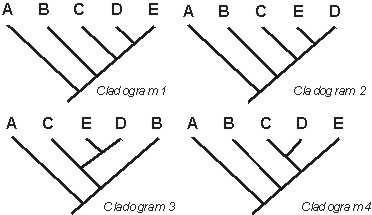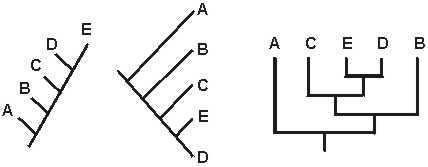GEOL 104 Dinosaurs: A Natural History
Fall Semester 2000
Systematics III: What is a dinosaur (version 2)?
Fun with Cladograms!
In a cladogram, it is the branching relationships which are important, not the "right
to left"/"top to bottom" order. As long as two cladograms contain the same branching relationships,
and do not have any contradictory branching relationships, they are equivalent:

In the above cases,cladograms 1-3 are all equivalent: they represent the same information.
However, cladogram 4 is not equivalent to the other three:
Cladogram 4 says that C and D are more closely related (share a more recent common ancestor)
with each other than either do with E, but in the other cladograms D is more closely related
to E than to C.
The below pictures are all equivalent to cladogram 1 above, but just drawn in different ways:

In a cladogram, terminal taxa can be expanded to show the relationships within them,
and nodes can be collapsed if we aren't interested in the details within that group.
For example, if we were not interested in reptile evolution, but were more interested in
mammalian relationships, we can modify the tetrapod cladogram from last
lecture to show the following:

This cladogram was modified from the previous one by:
- Collapsing the Reptilia node
- Expanding the Mammalia node
- Rotating at the Amniota node
The cladogram is equivalent to the previous one insofar as it doesn't violate any of the
branching relationships, but it:
- Conveys more information about mammal relationships, but
- Conveys less information about reptile relationships
More on Systematics and Taxonomy
In Lecture 10 we saw how names can be placed on nodes or terminal taxa.
Here we look in some more detail about names and cladograms.
Previously named groups of organisms can be evaluated based on cladograms. These groups
might be:
- Monophyletic: represent an immediate common ancestor and ALL of its descendants;
- Paraphyletic: represent an immediate ancestor and some but not all of its descendants;
- Polyphyletic: represent two or more independent groups with no immediate common ancestor that is
also part of that group.
In modern systematics only monophyletic groups are used: paraphyletic
groups are redefined to encompass monophyletic groups, or are abandoned.
Another name for a monophyletic group is a clade; modern systematics is thus called
cladistics.
Diagnosis of a taxon: the list of features that are synapomorphies at that node
(or autapomorphies, if a terminal taxon).
Definition of a taxon (in cladistics): a statement of common ancestry which
describes a particular clade.
Definitions can be node-based (all descendants of the most recent common ancestor
of taxon X and taxon Y) or stem-based (taxon X and all taxa sharing a more recent
common ancestor with taxon X than with taxon Y). The actual ancestors are only very
rarely known, but can be inferred by the joining of two branches at a node.
Owen's Dinosauria is now defined (with a node-based definition) as:
Dinosauria = all descendants of the most recent common ancestor of Iguanodon and
Megalosaurus.
(Dinosauria is thus has a node-based definition).
Dinosauria has two major branches, Saurischia and Ornithischia:
Saurischia = Megalosaurus and all taxa closer to Megalosaurus than to
Iguanodon.
Ornithischia = Iguanodon and all taxa closer to Iguanodon than to Megalosaurus.
We will discuss the diagnoses (synapomorphies) of these groups, and the various subgroups
within these clades, throughout the second section of the course.
NOTE: The definition for Dinosauria used here (all descendants of the most recent common
ancestor of Iguanodon and Megalosaurus) is, sadly, not the formal scientific definition
because of priority. For information on the actual accepted definitions of Dinosauria, S
aurischia, and Ornithischia in the scientific literature, click here.
To Next Lecture.
To Previous Lecture.
To Syllabus.


